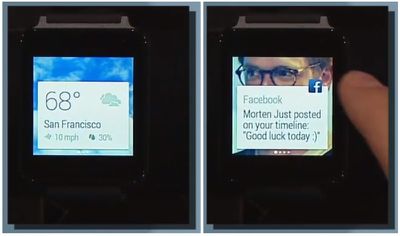At today's Google I/O event in San Francisco, Google demoed its Android Wear platform and announced availability of the first Android Wear devices. First announced in March, Android Wear is designed to bring the Android platform to a range of wearable devices from several of Google's manufacturing partners.

As described on stage, Google has designed Android Wear with many of the features and functions that rumors have suggested Apple's own iWatch might include. Android Wear supports screens of multiple sizes and styles, including both square and circular. With its always-on display and card-based UI, it displays information like notifications and location-based reminders.
Largely controlled by voice via Google Now integration, Android Wear also supports contextual apps that display information at a glance and it also integrates with several sensors, such as those that monitor steps taken and even heart rate on supported devices. It includes Google Maps support, offering turn-by-turn directions on the wrist and it can be used to control other devices, such as speakers.
Android Wear devices are reliant on a connected smartphone, much like the iWatch is expected to be reliant on the iPhone. Apps that are downloaded from the Google Play Store are able to include a wearable portion, which is automatically installed on a compatible Android Wear device when downloaded on a smartphone, extending available app functionality to the wrist.
On stage, demonstrations of Android Wear gave a clear idea of what we might expect from other wearables in the future, including the iWatch. A Lyft car was ordered via a simple voice command, with the watch automatically detecting a location. Ordering the car, payment, and update notifications on the driver's location were all displayed directly on wrist, without the need to access a smartphone.

Google announced the release of the full Android Wear SDK, along with the launch of the first devices supporting Android Wear. The LG G Watch is available for order today, as is the Samsung Gear Live, a new Samsung watch that supports Android. The platform's first circular watch taking advantage of the round UI, the Moto 360, will be available later this summer, and additional devices are in development by various partners.
By focusing on a platform rather than a device of its own, Google has managed to get Android onto wrists several months ahead of Apple. According to the most recent rumors, Apple's much-rumored smart watch won't launch until later this year, possibly at an October event. The iWatch expected to have a strong focus on health and fitness, with more than ten sensors to collect various types of data.






















